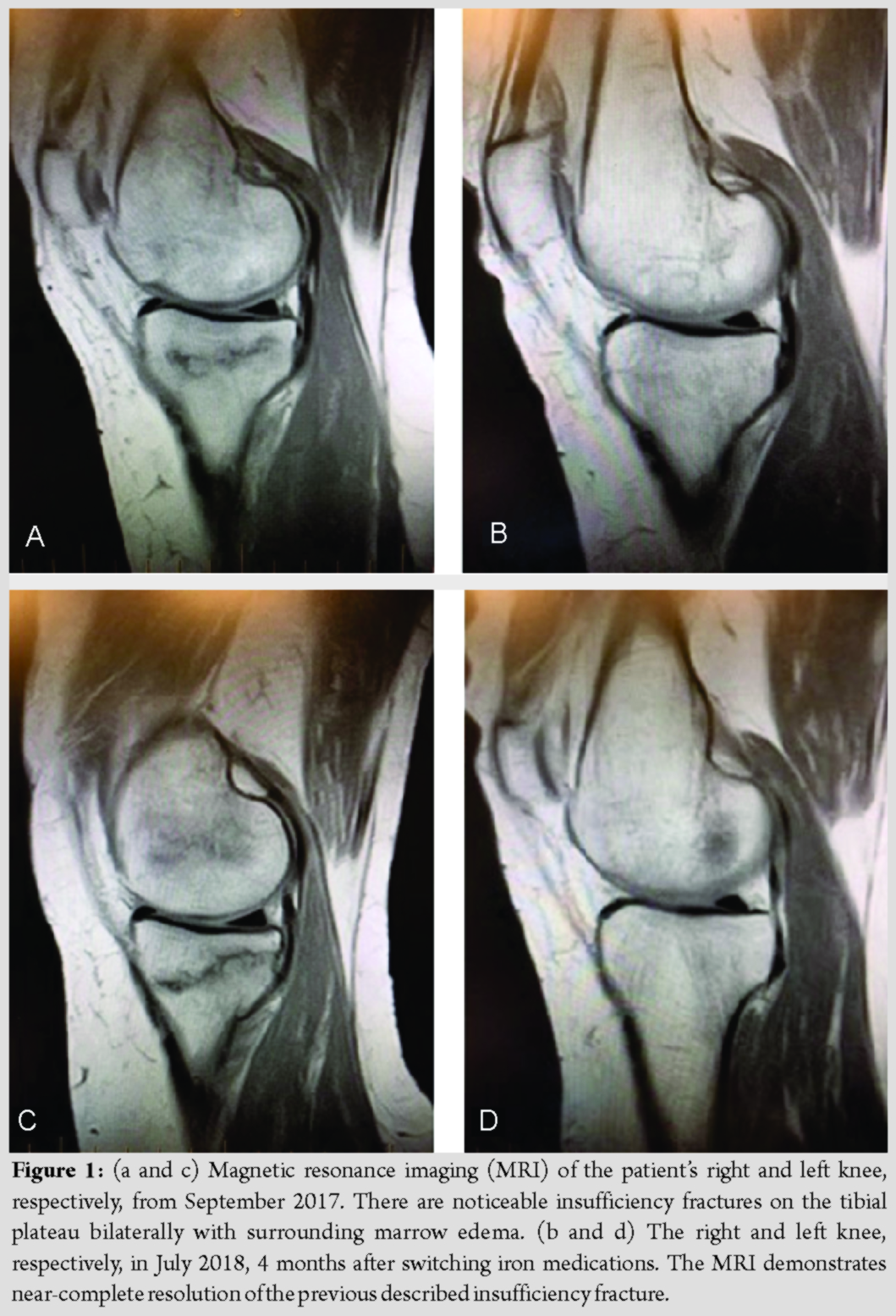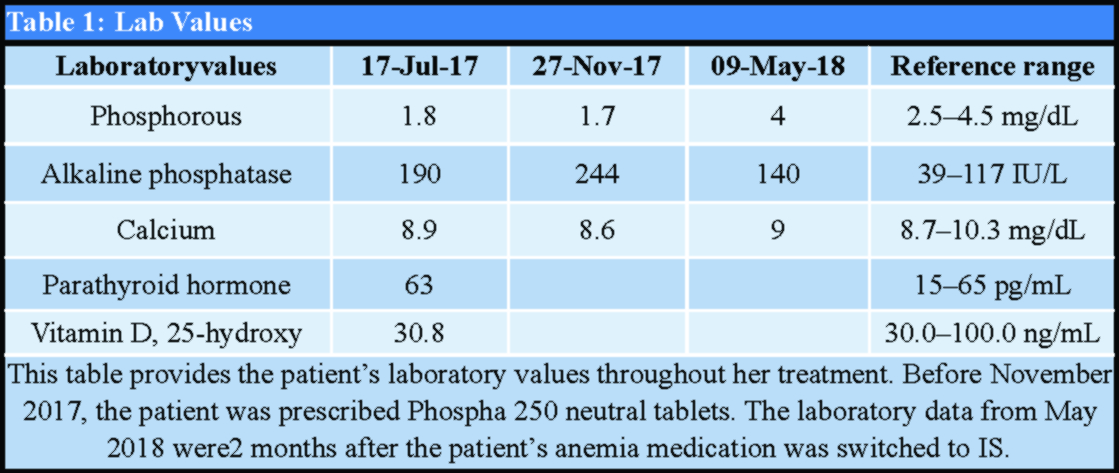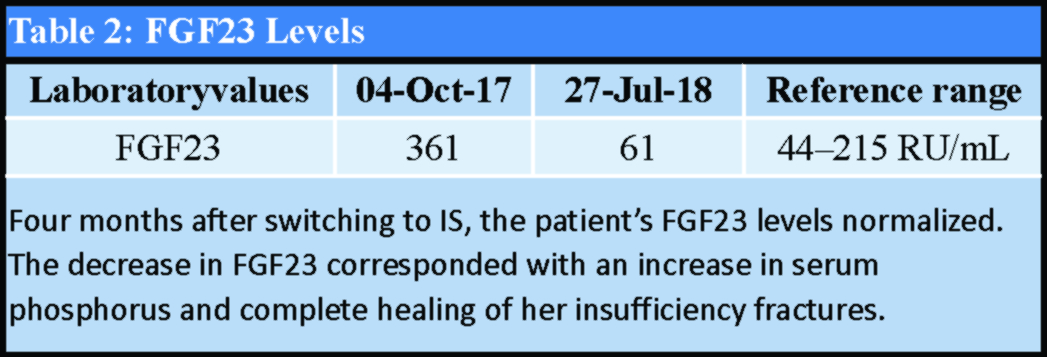[box type=”bio”] Learning Point of the Article: [/box]
Certain intravenous iron therapies are associated with hypophosphatemia and subsequent osteomalacia, and therefore awareness of these complications may reduce patient morbidity.
Case Report | Volume 10 | Issue 1 | JOCR January – February 2020 | Page 4-7 | Declan Tozzi, John Tozzi. DOI: 10.13107/jocr.2020.v10i01.1612
Authors: Declan Tozzi[1], John Tozzi[2]
[1]Robert Wood Johnson Medical School, 675 Hoes Ln W, Piscataway Township, New Jersey 08854, United States,
[2]Chairman Department of Orthopedics, Jersey Shore University Medical Center 1945 NJ-33, Neptune City,NJ,07753.
Address of Correspondence:
Dr. Declan Tozzi,
Robert Wood Johnson Medical School, 675 Hoes Ln W, Piscataway Township, New Jersey 08854, United States.
E-mail: dpt45@rwjms.rutgers.edu
Abstract
Introduction: Intravenous (IV) iron therapy is associated with hypophosphatemia, and long-term administration may lead to osteomalacia and insufficiency fracture. Awareness of this complication could severely reduce patient morbidity. Our patient continued her iron therapy for 17 months after her initial complaint. After switching iron medications, the patient’s fractures healed completely and she is now pain free.
Case Report: A 61-year-old woman presented with a fracture in her right femoral neck and a non-displaced fracture in her left femoral neck. After total hip arthroplasty and pinning, the patient returned with bilateral insufficiency fractures of the medial tibial plateau. The fractures were secondary to her iron medication, ferric carboxymaltose (FCM).
Conclusion: Fibroblast growth factor 23 (FGF23) is a protein that increases renal phosphate wasting and certain parenteral iron therapies may increase the activity of FGF23. Most IV iron medications have been shown to cause hypophosphatemia, but literature has indicated that FCM is associated with the highest risk of developing hypophosphatemia and possibly osteomalacia.
Keywords: Insufficiency fracture, osteomalacia, iron therapy, hypophosphatemia, fibroblast growth factor 23.
Introduction
The following case represents a serious complication of long-term intravenous (IV) iron therapy. Ferric carboxymaltose (FCM), an IV iron treatment, has become a popular therapy due to its effectiveness, low cost [1], and lack of gastrointestinal side effects [2]. Here, we describe a case of hypophosphatemic osteomalacia and subsequent insufficiency fractures induced by FCM treatment. Insufficiency (stress) fractures are incomplete microfractures caused by repetitive bone stress overtime, and therefore, are commonly seen in military recruits and athletes [3, 4]. Insufficiency fractures can also be triggered by normal stress when bone is pathologically weakened, as was the case with our patient. In a state of hypophosphatemia, hydroxyapatite formation is negatively impacted, leading to decreased bone mineralization and osteomalacia. Similar reports of FCM-induced hypophosphatemic osteomalacia with fracture have been reported in Crohn’s disease patients [2, 5]. Fibroblast growth factor 23 (FGF23), a key regulator of phosphate metabolism, appears to play a major role in this complication. Biologically active or intact FGF23 (iFGF23) down regulates phosphate reabsorption in the proximal tubule of the kidney, thus, causing phosphaturia. Our body controls excess levels of iFGF23 by cleaving it into an inactive form known as C-terminal FGF23 (cFGF23) [6]. It has been hypothesized that FCM treatment may disrupt this cleavage process, leading to excess iFGF23 and subsequent hypophosphatemia [7]. We hope that this case report will make physicians more cognizant of the complications of long-term iron infusion therapy. FCM-induced hypophosphatemia negatively impacts bone integrity and overtime, can have debilitating effects on the body. When the underlying cause is unknown or incorrectly attributed to other factors, we increase the patient morbidity. It is easier to attribute insufficiency fractures in a postmenopausal woman to age-related osteoporosis than to an issue with phosphate metabolism. However, with the knowledge of this complication, a proper history could be enough to clue one into the true etiology of a patient’s bone disorder.
Case Report
In December 2016, a 61-year-old woman was referred to our orthopedic clinic suffering from bilateral upper thigh pain. Amagnetic resonance imaging (MRI) revealed a displaced fracture on the right femoral neck and a non-displaced fracture on the left femoral neck. Her medical history was characterized by hepatitis C with cirrhosis, varices, and hypersplenism, leading to thrombocytopenia. She reports she received FCM injections every 4 weeks for her anemia. In February 2017, the patient underwent total hip arthroplasty on her right side and a pinning of her left hip. In May 2017, the patient returned to the clinic due to bilateral knee pain. MRI revealed insufficiency fractures of the right medial distal femur and right medial tibial plateau (Fig. 1a). The left knee demonstrated an insufficiency fracture of the medial tibial plateau with extensive surrounding marrow edema (Fig. 1c). Laboratory data from July 2017 indicated hypophosphatemia and increased alkaline phosphatase (Table 1). Serum calcium, parathyroid hormone, thyroid-stimulating hormone, and Vitamin D, 25-hydroxy were all normal (Table 1). Bone mineral density assessment by dual-energy X-ray absorptiometry qualified her bone loss as osteoporosis. In March 2018, the patient’s hematologist switched her iron medication to iron sucrose (IS). After switching medications, her serum phosphate and FGF23 levels normalized (Tables 1 and 2) and MRI revealed near-complete healing of her insufficiency fractures bilaterally (Fig. 1b and d).
Discussion
In this case, we experienced a 61-year-old patient who presented with multiple insufficiency fractures. The patient lacked any recent trauma and was not exposed to any new or unusual repetitive stress. In addition, the location of the stress fractures (medial tibial plateau) was fairly uncommon [3, 4]. The lack of trauma and unusual placement of the stress fractures could be a clue to future physicians that something abnormal is occurring. The osteomalacia and subsequent insufficiency fractures appeared to have been provoked by the patient’s iron therapy, FCM. Similar reports of FCM-induced hypophosphatemic osteomalacia with fracture have been reported in Crohn’s disease patients and FGF23 appears to play a key role [2, 5]. The FGF23 protein is released by osteocytes to regulate phosphate metabolism. Intact FGF23 (iFGF23) induces phosphaturia by down regulating sodium-dependent phosphate reabsorption in the proximal tubule of the kidney. Excess iFGF23 is cleaved into inactive cFGF23, but certain IV iron medications may disrupt this process.
Recent mouse [8, 9] and human studies [7] have shown that iron deficiency (ID) is associated with increased FGF23 transcription. There has been speculation that the increase is due to hypoxia-inducible factor 1α (HIF1α) [8, 9]. HIF1α regulates gene expression and its degradation is iron dependent. Therefore, in a state of ID, its half-life and activity are increased. In a healthy individual, the increased production of iFGF23 can be matched with increased cleavage [6]. Autosomal-dominant hypophosphatemic rickets (ADHR) can present with similar symptoms as those experienced by our patient, and research indicates that the proteolytic cleavage step in ADHR patients is compromised, leading to an increased iFGF23 to cFGF23 ratio [9]. On the other hand, the increased renal phosphate excretion observed in tumor-induced osteomalacia is due to inappropriate tumor production of FGF23.
That leads us to understand why iron infusion therapy can lead to hypophosphatemia. A randomized control trial comparing FCM to iron dextran treatment in ID women showed that both iron treatments lowered cFGF23. However, only FCM increased iFGF23 and led to hypophosphatemia. The authors hypothesized that the preparation of FCM injections, specifically the carbohydrate moieties, inhibits the degradation of iFGF23 [7]. Thus, IV iron lowers FGF23 transcription, but certain therapies may increase the net level of iFGF23 and lead to hypophosphatemia. This explains the improvement in our patient’s serum phosphate and insufficiency fractures when taken off of FCM. In contrast to our patient’s improvement with IS treatment, there have been reports of iron-induced osteomalacia with IS [5, 10, 11] and iron polymaltose therapies [12]. A prospective study investigating parenteral iron therapy in 8 ID females found elevated FGF23 levels and accompanying hypophosphatemia with a single infusion of iron polymaltose [13]. It appears then that most parenteral forms of iron can lead to hypophosphatemia and potentially osteomalacia with long-term use; although, reviews of literature [14] and prospective studies [1,15] have indicated that FCM is associated with a higher risk of hypophosphatemia.
Conclusion
It is important for physicians to be aware of the complications of IV iron treatment because, as was the case with our patient, a delay in diagnosis can lead to increased injury. Seventeen months after the patient’s initial complaint of hip pain, her medication was changed from FCM to IS. During that time, the patient suffered from back, hip, and knee pain and numerous osteomalacia-related stress fractures. The eventual change in her iron medication resolved her pain and resolved her insufficiency fractures. This simple change circumvented the need for knee replacement surgery and could help future patients prevent unnecessary invasive treatment.
Clinical Message
We hope our case will reduce patient morbidity by raising awareness of the complications of certain IV iron therapies. Meanwhile, reviewing the function of FGF23 and its relevance to osteomalacia can increase physician understanding of this pathology.
References
1. BagerP, HvasCL, DahlerupJF. Drug-specific hypophosphatemia and hypersensitivity reactions following different intravenous iron infusions.Br J Clin Pharmacol2017;83:1118-25.
2. KleinK, AsaadS, EconsM, RubinJE. Severe FGF23-based hypophosphataemicosteomalacia due to ferric carboxymaltose administration.BMJ Case Rep2018;2018:bcr-2017-222851.
3. Kiel J, Kaiser K. Stress Reaction and Fractures. Treasure Island (FL): StatPearls; 2018.
4. YukataK, YamanakaI, UedaY, NakaiS, OgasaH, OishiY, et al. Medial tibial plateau morphology and stress fracture location: A magnetic resonance imaging study.World J Orthop2017;8:484-90.
5. BartkoJ, RoschgerP, ZandiehS, BrehmA, ZwerinaJ, KlaushoferK. Hypophosphatemia, severe bone pain, gait disturbance, and fatigue fractures after iron substitution in inflammatory bowel disease: A case report.J Bone Miner Res2018;33:534-9.
6. WolfM, WhiteKE. Coupling fibroblast growth factor 23 production and cleavage: Iron deficiency, rickets, and kidney disease. CurrOpinNephrol Hypertens 2014;23:411-9.
7. WolfM, KochTA, BregmanDB. Effects of iron deficiency anemia and its treatment on fibroblast growth factor 23 and phosphate homeostasis in women.J Bone Miner Res2013;28:1793-803.
8. DavidV, MartinA, IsakovaT, SpauldingC, QiL, RamirezV, et al. Inflammation and functional iron deficiency regulate fibroblast growth factor 23 production.Kidney Int2016;89:135-46.
9. FarrowEG, YuX, SummersLJ, DavisSI, FleetJC, AllenMR, et al. Iron deficiency drives an autosomal dominant hypophosphatemic rickets (ADHR) phenotype in fibroblast growth factor-23 (Fgf23) knock-in mice.Proc Natl Acad Sci USA2011;108:E1146-55.
10. IshimaruD, SumiH. A case of an insufficiency fracture of the medial proximal tibia secondary to osteomalacia associated with long-term saccharated ferric oxide administration.Case Rep Orthop2017;2017:1675654.
11. OkadaM, ImamuraK, IidaM, FuchigamiT, OmaeT. Hypophosphatemia induced by intravenous administration of saccharated iron oxide.KlinWochenschr1983;61:99-102.
12. SchoutenBJ, DoogueMP, SouleSG, HuntPJ. Iron polymaltose-induced FGF23 elevation complicated by hypophosphataemicosteomalacia.Ann Clin Biochem2009;46:167-9.
13. SchoutenBJ, HuntPJ, LiveseyJH, FramptonCM, SouleSG. FGF23 elevation and hypophosphatemia after intravenous iron polymaltose: A prospective study.J Clin Endocrinol Metab2009;94:2332-7.
14. ZollerH, SchaeferB, GlodnyB. Iron-induced hypophosphatemia: An emerging complication.CurrOpinNephrolHypertens2017;26:266-75.
15. SchaeferB, WürtingerP, FinkenstedtA, BraithwaiteV, ViveirosA, EffenbergerM, et al. Choice of high-dose intravenous iron preparation determines hypophosphatemia risk.PLoS One2016;11:e0167146.
 |
 |
| Dr. Declan Tozzi | Dr. John Tozzi |
| How to Cite This Article: Tozzi D, Tozzi J. Osteomalacia and Insufficiency Fractures Secondary to Intravenous Iron Therapy: A Case Report. Journal of Orthopaedic Case Reports 2020 Jan-Feb;10(1): 4-7. |
[Full Text HTML] [Full Text PDF] [XML]
[rate_this_page]
Dear Reader, We are very excited about New Features in JOCR. Please do let us know what you think by Clicking on the Sliding “Feedback Form” button on the <<< left of the page or sending a mail to us at editor.jocr@gmail.com







